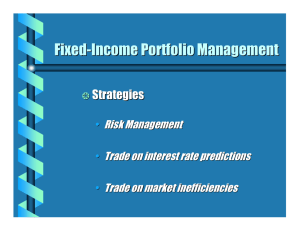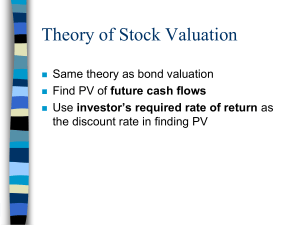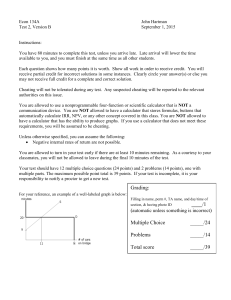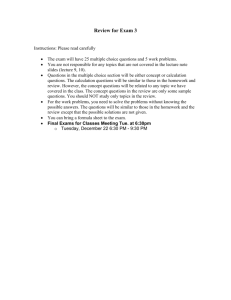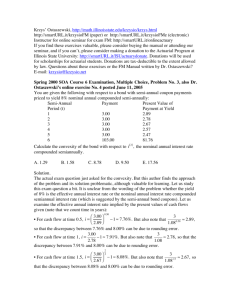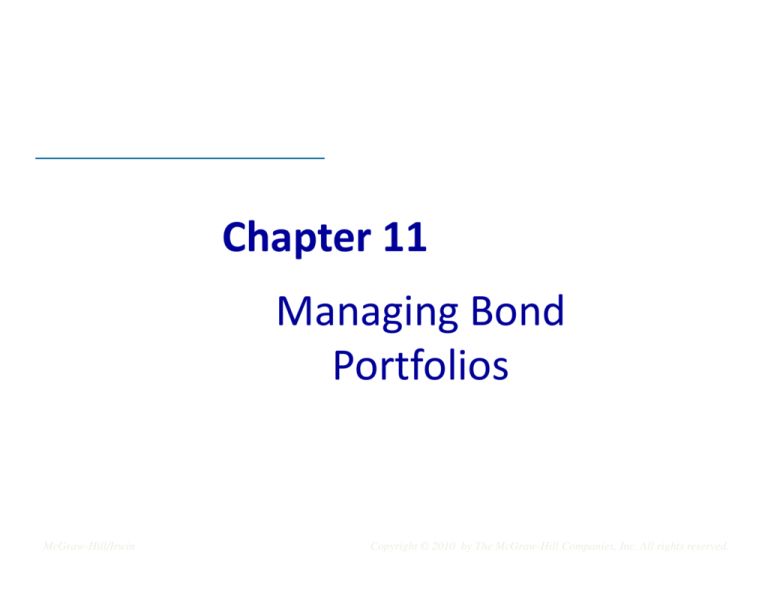
Chapter 11
Managing Bond
Portfolios
McGraw-Hill/Irwin
Copyright © 2010 by The McGraw-Hill Companies, Inc. All rights reserved.
Duration/Price Relationship
• Price change is proportional to duration and
not to maturity
∆P/P = -D x [∆y / (1+y)]
D* = D / (1+y) : modified duration
∆P/P = - D* x ∆y
So, D* represent interest rate elasticity of bond’s
price.
11-2
11.2 Passive Bond Management
11-3
Interest Rate Risk
Interest rate risk is the possibility that an investor does not earn the
promised ytm because of interest rate changes.
A bond investor faces two types of interest rate risk:
1.Price risk: The risk that an investor cannot sell the bond for as much
as anticipated. An increase in interest rates reduces the sale price.
2.Reinvestment risk: The risk that the investor will not be able to
reinvest the coupons at the promised yield rate. A decrease in interest
rates reduces the future value of the reinvested coupons.
The two types of risk are potentially offsetting.
11-4
Immunization
• Immunization: An investment strategy
designed to ensure the investor earns the
promised YTM.
11-5
Growth of Invested Funds
1. Target Date Immunization
11-6
Immunization
2. Net worth immunization
• The equity of an institution can be immunized
by matching the duration of the assets to the
duration of the liabilities.
11-7
Figure 11.4 Immunization
11-8
Cash Flow Matching and Dedication
• Cash flow from the bond and the obligation exactly offset
each other
– Automatically immunizes a portfolio from interest rate
movements
• Not widely pursued, too limiting in terms of choice of bonds
• May not be feasible due to lack of availability of investments
needed
11-9
11.3 Convexity
11-10
The Need for Convexity
• Duration is only an approximation
• Duration asserts that the percentage price
change is linearly related to the change in the
bond’s yield
– Underestimates the increase in bond prices when
yield falls
– Overestimates the decline in price when the yield
rises
11-11
Pricing Error Due to Convexity
11-12
Convexity: Definition and Usage
1
Convexity =
P × (1 + y )2
CFt
2
∑
(1 + y )t ( t + t )
t =1
n
Where: CFt is the cash flow (interest and/or principal) at time t and y = ytm
The prediction model including convexity is:
∆P
∆y
= −D ×
+ 1/ 2 × Convexity × ∆y 2
P
(1 + y )
[
]
11-13
Convexity of Two Bonds
11-14
Chapter 13
Equity Valuation
Valuation Methods
• Book value
– Value of common equity on the balance sheet
– Based on historical values of assets and liabilities,
which may not reflect current values
– Some assets such as brand name or specialized
skills are not on a balance sheet
– Is book value a floor value for market value of
equity?
13-16
Valuation Methods
• Market value
– Current market value of assets minus current
market value of liabilities
• Market value of assets may be difficult to ascertain
– Market value based on stock price
– Better measure than book value of the worth of
the stock to the investor.
13-17
Valuation Methods (Other Measures)
• Liquidation value
– Net amount realized from sale of assets and
paying off all debt
– Firm becomes a takeover target if market value
stock falls below this amount, so liquidation value
may serve as floor to value
13-18
Valuation Methods (Other Measures)
• Replacement cost
– Replacement cost of the assets less the liabilities
– May put a ceiling on market value in the long run
because values above replacement cost will
attract new entrants into the market.
– Tobin’s Q = Market Value / Replacement Cost;
should tend toward 1 over time.
13-19
13.2 Intrinsic Value Versus Market Price
13-20
Expected Holding Period Return
• The return on a stock investment comprises
cash dividends and capital gains or losses
– Assuming a one-year holding period
Expected HPR= E ( r ) =
E ( D1 ) + [ E ( P1 ) − P0
]
P0
13-21
Required Return
k = rf + β E (rM ) − rf
• CAPM gave us required
return, call it k:
• k = market capitalization
rate
• If the stock is priced
correctly
– Required return should
equal expected return
k = r f + β E ( rM ) − r f
=
Expected HPR= E (r ) =
E ( D1 ) + [ E ( P1 ) − P0
]
P0
13-22
Intrinsic Value
Intrinsic Value
• The present value of a firm’s expected future net cash flows
discounted by a risk adjusted required rate of return.
• The cash flows on a stock are?
– Dividends (Dt)
E(D1 ) + E(P1 )
– Sale price (Pt)
V0 =
1 + kfor a one year
• Intrinsic Value today (time 0) is denoted V0 and
holding period may be found as:
13-23
Intrinsic Value and Market Price
• Market Price
– Consensus value of all traders
– In equilibrium the current market price will equal
intrinsic value
• Trading Signals
– If V0 > P0
– If V0 < P0
– If V0 = P0
Buy
Sell or Short Sell
Hold as it is Fairly Priced
13-24
13.3 Dividend Discount Models
For now assume price = intrinsic value
13-25
Basic Dividend Discount Model
Intrinsic value of a stock can be found from the
following:
∞
Dt
V0 = ∑
t
t =1 (1 + k )
V0 = Intrinsic Value of Stock
Dt = Dividend in time t
k = required return
What happened to the expected sale price in this
formula?
• Why is this an infinite sum?
• Is stock price independent of the investor’s holding
period?
13-26
Basic Dividend Discount Model
Intrinsic value of a stock can be found from the
V0 = Intrinsic Value of Stock
following:
∞
Dt
V0 = ∑
t
(
1
+
k
)
t =1
Dt = Dividend in time t
k = required return
• This equation is not useable because it is an infinite
sum of variable cash flows.
• Therefore we have to make assumptions about the
dividends to make the model tractable.
13-27
No Growth Model
• Use: Stocks that have earnings and dividends
that are expected to remain constant over
time (zero growth)
D
V0 =
k
– Preferred Stock
• A preferred stock pays a $2.00 per share dividend and
the stock has a required return of 10%. What is the
most you should be willing to pay for the stock?
$2.00
V0 =
= $20.00
0.10
13-28
Constant Growth Model
• Use: Stocks that have earnings and dividends that are
expected to grow at a constant rate forever
D0 × (1 + g )
V0 =
; g = perpetual growth rate in dividends
k -g
• A common stock share just paid a $2.00 per share
dividend and the stock has a required return of 10%.
Dividends are expected to grow at 6% per year
forever. What is the most you should be willing to
pay for the stock?
$2.00 × 1.06
V0 =
= $53.00
0.10 - 0.06
13-29

